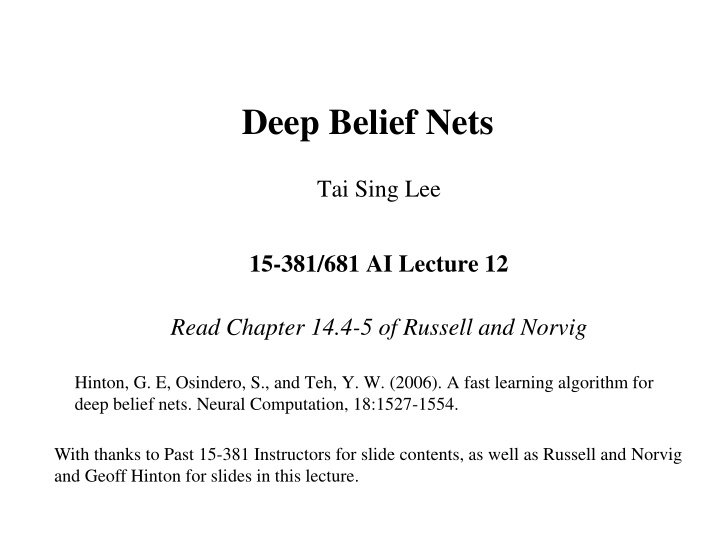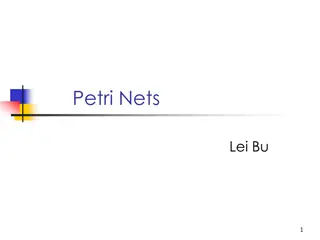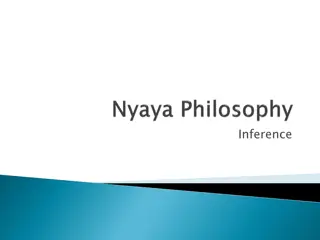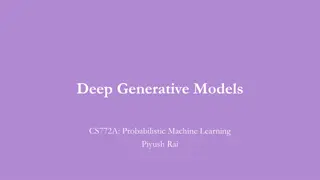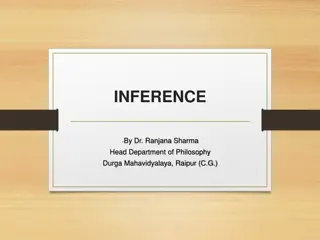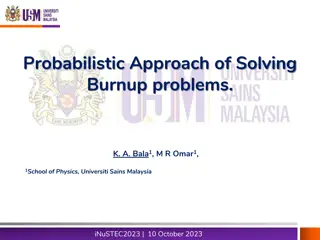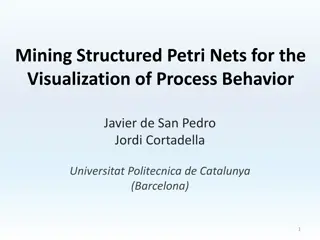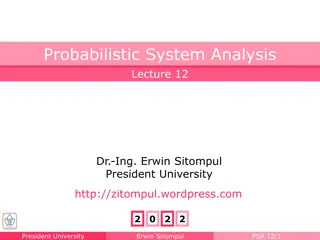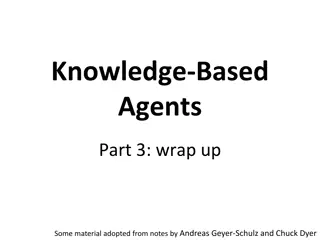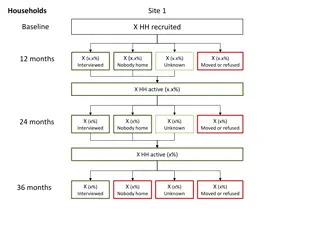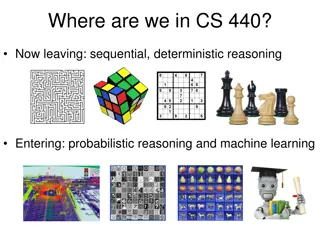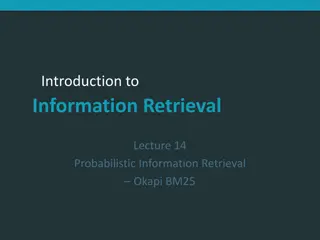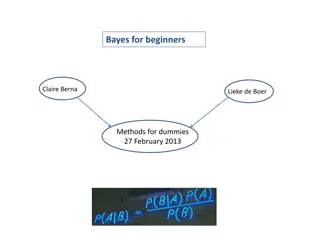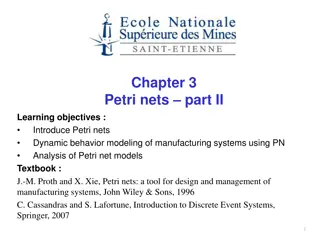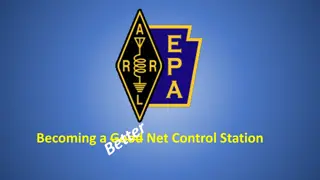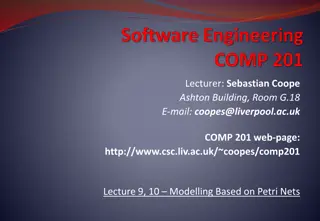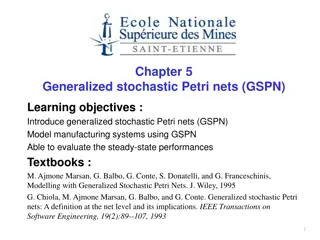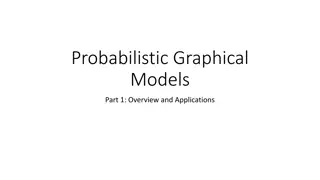Introduction to Deep Belief Nets and Probabilistic Inference Methods
Explore the concepts of deep belief nets and probabilistic inference methods through lecture slides covering topics such as rejection sampling, likelihood weighting, posterior probability estimation, and the influence of evidence variables on sampling distributions. Understand how evidence affects the estimation of probabilities and how likelihood weighting helps in generating consistent samples with respect to evidence variables.
Download Presentation

Please find below an Image/Link to download the presentation.
The content on the website is provided AS IS for your information and personal use only. It may not be sold, licensed, or shared on other websites without obtaining consent from the author.If you encounter any issues during the download, it is possible that the publisher has removed the file from their server.
You are allowed to download the files provided on this website for personal or commercial use, subject to the condition that they are used lawfully. All files are the property of their respective owners.
The content on the website is provided AS IS for your information and personal use only. It may not be sold, licensed, or shared on other websites without obtaining consent from the author.
E N D
Presentation Transcript
Deep Belief Nets Tai Sing Lee 15-381/681 AI Lecture 12 Read Chapter 14.4-5 of Russell and Norvig Hinton, G. E, Osindero, S., and Teh, Y. W. (2006). A fast learning algorithm for deep belief nets. Neural Computation, 18:1527-1554. With thanks to Past 15-381 Instructors for slide contents, as well as Russell and Norvig and Geoff Hinton for slides in this lecture.
Pr(Cloudy | Sprinkler=T,Rain=T)? Cloudy Rain Sprinkler Wet Grass Samples of Cloudy given Sprinkler=T & Rain=T): 1 0 1 1 0 1 1 1 1 0 Posterior probability of taking on any value given some evidence: Pr[Q | E1=e1,...,Ek=ek] Pr(Cloudy = T | Sprinkler=T, Rain=T) .7 Pr(Cloudy = F | Sprinkler=T, Rain=T) .3 2
Rejection sampling What about when we have evidence? Want to estimate Pr[Rain=t|Sprinkler=t] using 100 direct samples 73 have S=f, of which 12 have R=t 27 have S=t, of which 8 have R=t What s the estimate? 1. 20/100 2. 12/73 3. 8/27 4. Not sure. 3 What if S=t, happen very rarely?
Likelihood Weighting Recap: W[x] = Total Weight 4
Likelihood weighting +c -c 0.5 0.5 Want P(R| C=t,W=t) Evidence variables: C=t,W=t Order:C, S, R, W w = 1 Pr[C=t] = 0.5 Sample Pr[S|C=t]=(.1,.9) false Sample Pr[R|C=t]=(.8,.2) true W is evidence var w = 0.5 Pr[W=t|S=f,R=t] = .45 Sampled [t,f,t,t] with weight .45, tallied under R=t Cloudy +c +s .1 +c -s -c +s .5 -c -s +c +r .8 +c -r -c +r .2 -c -r .9 .2 Rain Sprinkler .5 .8 Wet Grass +s +r +w .99 +s +r -w .01 +s -r +w .90 +s -r -w .10 -s +r +w .90 -s +r -w .10 -s -r +w 0 -s -r -w 1.0 This generated one weighted sample 5
Intuition The distribution of the sample value of R or S drawn is influenced by evidence variable C=t, their parents But the non-descendent evidence due to W=t is ignored (for the time being). C=t Cloudy Will generate many samples with S=f and R = f, despite it is not consistent with evidence W=t. Rain Sprinkler Wet Grass However, when sampling reaches evidence W=t, the likelihood weight w will take care of that, making the sampling consistent with the P(z|e). w could be very small because it is unlikely W would be t if S=f, R=f. W=t 6
Pool Recall: Want P(R| C=t,W=t), 500 samples (R=t, , C=t, W=t) and (R=f, C=t, W=t) are generated by likelihood weighting. If we have 100 samples with R=t and total weight 1, and 400 samples with R=f and total weight 2, what is estimate of R=t? 1. 1/9 2. 1/3 3. 1/5 4. no idea. Total weight is W, not w. 7
Likelihood Weighting Recap: W[x] = Total Weight 8
Markov Chain Monte Carlo Methods Direct, rejection and likelihood weighting methods generate each new sample from scratch MCMC generate each new sample by making a random change to preceding sample 9
Gibbs sampling State of network = current assignment to all variables. Generate next state by sampling one variable given Markov blanket Sample each variable in turn, keeping evidence fixed 10
Gibbs sampling From G. Mori 11
Gibbs sampling From G. Mori 12
Gibbs Sampling Example +c -c 0.5 0.5 Want to estimate Pr(R|S=t,W=t) Non-evidence variables are C & R Initialize randomly: C= t and R=f Initial state (C,S,R,W)= [t,t,f,t] Sample C given current values of its Markov Blanket What is its Markov blanket? Cloudy +c +s .1 +c -s -c +s .5 -c -s +c +r .8 +c -r -c +r .2 -c -r .9 .2 Rain Sprinkler .5 .8 Wet Grass +s +r +w .99 +s +r -w .01 +s -r +w .90 +s -r -w .10 -s +r +w .90 -s +r -w .10 -s -r +w 0 -s -r -w 1.0 13
Gibbs Sampling Example +c -c 0.5 0.5 Want Pr(R|S=t,W=t) Non-evidence variables are C & R Initialize randomly: C= t and R=f Initial state (C,S,R,W)= [t,t,f,t] Sample C given current values of its Markov Blanket Markov blanket is parents, children and children s parents: Cloudy +c +s .1 +c -s -c +s .5 -c -s +c +r .8 +c -r -c +r .2 -c -r .9 .2 Rain Sprinkler .5 .8 Wet Grass +s +r +w .99 +s +r -w .01 +s -r +w .90 +s -r -w .10 -s +r +w .90 -s +r -w .10 -s -r +w 0 -s -r -w 1.0 14
Gibbs Sampling Example +c -c 0.5 0.5 Want Pr(R|S=t,W=t) Non-evidence variables are C & R Initialize randomly: C= t and R=f Initial state (C,S,R,W)= [t,t,f,t] Sample C given current values of its Markov Blanket Markov blanket is parents, children and children s parents: Sample C given P(C|S=t,R=f) First have to compute P(C|S=t,R=f) Use exact inference to do this Cloudy +c +s .1 +c -s -c +s .5 -c -s +c +r .8 +c -r -c +r .2 -c -r .9 .2 Rain Sprinkler .5 .8 Wet Grass +s +r +w .99 +s +r -w .01 +s -r +w .90 +s -r -w .10 -s +r +w .90 -s +r -w .10 -s -r +w 0 -s -r -w 1.0 15
Exercise: compute P(C=t|S=t,R=f)? +c -c 0.5 0.5 Quick refresher Sum rule Cloudy +c +s .1 +c -s -c +s .5 -c -s +c +r .8 +c -r -c +r .2 -c -r .9 .2 Rain Sprinkler .5 .8 Product/Chain rule Wet Grass +s +r +w .99 +s +r -w .01 +s -r +w .90 +s -r -w .10 -s +r +w .90 -s +r -w .10 -s -r +w 0 -s -r -w 1.0 Bayes rule 16
Exact Inference Exercise What is the probability P(C=t | S=t, R= f)? +c -c 0.5 0.5 Cloudy P(C=t | S=t, R= f) = P(C=t, S=t, R=f) / (P(S=t,R=f)) Proportional to P(C=t, S=t, R=f) Use normalization trick, & compute the above for C=t and C=f P(C=t, S=t, R=f) = P(C=t) P(S=t|C=t) P (R=f | C=t, S=t) product rule = P(C=t) P(S=t|C=t) P (R=f | C=t) (BN independencies) = 0.5 * 0.1 * 0.2 = 0.01 P(C=f, S=t, R=f) = P(C=f) P (S=t|C=f) P(R=f|C=f) = 0.5 * 0.5 * 0.8 = 0.2 (P(S=t,R=f)) use sum rule = P(C=f, S=t, R=f) + P(C=t, S=t, R=f) = 0.21 P (C=t | S=t, R = f) = 0.01 / 0.21 ~ 0.0476 +c +s .1 +c -s -c +s .5 -c -s +c +r .8 +c -r -c +r .2 -c -r .9 .2 Rain Sprinkler .5 .8 Wet Grass +s +r +w .99 +s +r -w .01 +s -r +w .90 +s -r -w .10 -s +r +w .90 -s +r -w .10 -s -r +w 0 -s -r -w 1.0 17
Gibbs Sampling Example +c -c 0.5 0.5 Want Pr(R|S=t,W=t) Non-evidence variables are C & R Initialize randomly: C= t and R=f Initial state (C,S,R,W)= [t,t,f,t] Sample C given current values of its Markov Blanket Exactly compute P(C|S=t,R=f) Sample C given P(C|S=t,R=f) Get C = f New state (f,t,f,t) Cloudy +c +s .1 +c -s -c +s .5 -c -s +c +r .8 +c -r -c +r .2 -c -r .9 .2 Rain Sprinkler .5 .8 Wet Grass +s +r +w .99 +s +r -w .01 +s -r +w .90 +s -r -w .10 -s +r +w .90 -s +r -w .10 -s -r +w 0 -s -r -w 1.0 18
Gibbs Sampling Example +c -c 0.5 0.5 Want Pr(R|S=t,W=t) Initialize non-evidence variables (C and R) randomly to t and f Initial state (C,S,R,W)= [t,t,f,t] Sample C given current values of its Markov Blanket, p(C|S=t,R=f) Get sample C=f New state (f,t,f,t) Sample Rain given its MB What is Rain s Markov blanket? Cloudy +c +s .1 +c -s -c +s .5 -c -s +c +r .8 +c -r -c +r .2 -c -r .9 .2 Rain Sprinkler .5 .8 Wet Grass +s +r +w .99 +s +r -w .01 +s -r +w .90 +s -r -w .10 -s +r +w .90 -s +r -w .10 -s -r +w 0 -s -r -w 1.0 19
Gibbs Sampling Example +c -c 0.5 0.5 Want Pr(R|S=t,W=t) Sample Rain given its MB, p(R|C=f,S=t,W=t) Get sample R=t New state (f,t,t,t) Cloudy +c +s .1 +c -s -c +s .5 -c -s +c +r .8 +c -r -c +r .2 -c -r .9 .2 Rain Sprinkler .5 .8 Wet Grass +s +r +w .99 +s +r -w .01 +s -r +w .90 +s -r -w .10 -s +r +w .90 -s +r -w .10 -s -r +w 0 -s -r -w 1.0 20
Poll: Gibbs Sampling Ex. +c -c 0.5 0.5 Want Pr(R|S=t,W=t) Initialize non-evidence variables (C and R) randomly to t and f Initial state (C,S,R,W)= [t,t,f,t] Current state (f,t,t,t) Cloudy +c +s .1 +c -s -c +s .5 -c -s +c +r .8 +c -r -c +r .2 -c -r .9 .2 Rain Sprinkler .5 .8 Wet Grass +s +r +w .99 +s +r -w .01 +s -r +w .90 +s -r -w .10 -s +r +w .90 -s +r -w .10 -s -r +w 0 -s -r -w 1.0 What is not a possible next state 1. (f,t,t,t) 2. (t,t,t,t) 3. (f,t,f,t) 4. (f,f,t,t) 5. Not sure 21
Gibbs sampling From G. Mori 22
Gibbs is Consistent Sampling process settles into a stationary distribution where long-term fraction of time spent in each state is exactly equal to posterior probability if draw enough samples from this stationary distribution, will get consistent estimate because sampling from true posterior See Proof in Textbook. 23
Belief Nets A belief net is a directed acyclic graph composed of stochastic variables. Hidden variables (not observed) and visible variables The inference problem: Infer the states of the unobserved variables. The learning problem: Learn interaction between variables to make the network more likely to generate the observed data. stochastic hidden causes visible units: observations
Stochastic binary units (Bernoulli variables) 1 These have a state (si ) of 1 or 0. = ( ) p is 1 The probability of turning on is determined by the weighted input from other units (plus a bias) 0 0 s j + b w i j ji 1 = = ( ) p s 1 j i + 1 exp( ) b s w i j ji
Two types of generative belief nets If we connect binary stochastic neurons in a directed acyclic graph we get a Sigmoid Belief Net (Radford Neal 1992). If we connect binary stochastic neurons using symmetric connections we get a Boltzmann Machine (Hinton & Sejnowski, 1983). If we restrict the connectivity in a special way, it is easy to learn a Boltzmann machine.
The Boltzmann Machine (Hinton and Sejnowski 1985) Energy of a state Probability of being in a state T = w connections
Learning in Boltzmann machine Hebbian learning fantasy/expectation input Direct sampling from the distributions Learn to model the data distribution of the observable units.
Weights Energies Probabilities Each possible joint configuration of the visible and hidden units has an energy The energy is determined by the weights and biases The energy of a joint configuration of the visible and hidden units determines its probability: e ( , ) E v h ( , ) p v h A state with lower energy has higher probability. The probability of a configuration over the visible units is found by summing the probabilities of all the joint configurations that contain it.
Conditional independence Recall, two dependent variables can be made conditional independent when they can be explained by a common cause. Alarm Mary call John call
Explaining away (Judea Pearl) On the other hand, if two hidden causes are independent, they can become dependent when we observe an effect that they can both influence. They compete to explain the observation! If we learn that there was an earthquake, it reduces the probability that the alarm is triggered by burglary. Burglary earthquake Alarm
Difficult to learn sigmoid belief nets To learn W, we need the posterior distribution in the first hidden layer. Problem 1: The posterior is typically complicated because of explaining away . Problem 2: The posterior depends on the prior as well as the likelihood. So to learn W, we need to know the weights in higher layers, even if we are only approximating the posterior. All the weights interact. Problem 3: We need to integrate over all possible configurations of the higher variables to get the prior for first hidden layer. Yuk! hidden variables hidden variables prior hidden variables likelihood W data
Restricted Boltzmann Machines (Smolensky ,1986, called them harmoniums ) We restrict the connectivity to make learning easier. Only one layer of hidden units. Learn one layer at a time No connections between hidden units. In an RBM, the hidden units are conditionally independent given the visible states. So we can quickly get an unbiased sample from the posterior distribution when given a data-vector. This is a big advantage over directed belief nets hidden j i visible
The Energy of a Joint Configuration binary state of visible unit i binary state of hidden unit j i , = v,h ( ) E v h w i j ij j Energy with configuration v on the visible units and h on the hidden units weight between units i and j ( , ) E v h = v h i j w ij
Using energies to define probabilities ( , ) E v h The probability of a joint configuration over both visible and hidden units depends on the energy of that joint configuration compared with the energy of all other joint configurations. e = ( , ) p v h u , ( , ) E u g e g partition function h The probability of a configuration of the visible units is the sum of the probabilities of all the joint configurations that contain it. ( , ) E v h e = ( ) p v u , ( , ) E u g e g Hinton
A picture of the maximum likelihood learning algorithm for an RBM j j j j 0 v ih v ih j j a fantasy i i i i t = 0 t = 1 t = 2 t = infinity Start with a training vector on the visible units. Then alternate between updating all the hidden units in parallel and updating all the visible units in parallel. log ( ) p v 0 = v h v h i j i j w Hinton ij
A quick way to learn an RBM Start with a training vector on the visible units. j j 0 1 v ih v ih j j Update all the hidden units in parallel i i Update the all the visible units in parallel to get a reconstruction . t = 0 t = 1 data Update the hidden units again. reconstruction = 0 1 ( ) w v h v h ij i j i j This is not following the gradient of the log likelihood. But it works well. It is approximately following the gradient of another objective function (Carreira-Perpinan & Hinton, 2005). Hinton
How to learn a set of features that are good for reconstructing images of the digit 2 50 binary feature neurons 50 binary feature neurons Decrement weights between an active pixel and an active feature Increment weights between an active pixel and an active feature = 0 1 ( ) w v h v h ij i j i j 16 x 16 pixel image 16 x 16 pixel image data (reality) reconstruction
The final 50 x 256 weights for learning digit 2 Each neuron grabs a different feature a cause, weighted sum of the causes to explain the input.
How well can we reconstruct the digit images from the binary feature activations ? Reconstruction from activated binary features Reconstruction from activated binary features Data Data New test images from the digit class that the model was trained on Images from an unfamiliar digit class (the network tries to see every image as a 2)
Training a deep belief net First train a layer of features that receive input directly from the pixels. Then treat the activations of the trained features as if they were pixels and learn features of features in a second hidden layer. It can be proved that each time we add another layer of features we improve the bound on the log probability of the training data. The proof is complicated. But it is based on a neat equivalence between an RBM and a deep directed model (described later)
DBN after learning 3 layers To generate data: 1. Get an equilibrium sample from the top-level RBM by performing alternating Gibbs sampling for a long time. 2. Perform a top-down pass to get states for all the other layers. h3 W 3 h2 W 2 h1 So the lower level bottom-up connections are not part of the generative model. They are just used for inference. W 1 data
A model of digit recognition The top two layers form an associative memory whose energy landscape models the low dimensional manifolds of the digits. 2000 top-level neurons 10 label neurons 500 neurons The energy valleys have names The model learns to generate combinations of labels and images. 500 neurons To perform recognition we start with a neutral state of the label units and do an up-pass from the image followed by a few iterations of the top-level associative memory. 28 x 28 pixel image
Samples generated by letting the associative memory run with one label clamped.
Examples of correctly recognized handwritten digits that the neural network had never seen before
Show the movie of the network generating digits (available at www.cs.toronto/~hinton)
An infinite sigmoid belief net that is equivalent to an RBM etc. T W h2 The distribution generated by this infinite directed net with replicated weights is the equilibrium distribution for a compatible pair of conditional distributions: p(v|h) and p(h|v) that are both defined by W A top-down pass of the directed net is exactly equivalent to letting a Restricted Boltzmann Machine settle to equilibrium. So this infinite directed net defines the same distribution as an RBM. Hinton, G. E, Osindero, S., and Teh, Y. W. (2006). A fast learning algorithm for deep belief nets. Neural Computation, 18:1527-1554. W v2 T W h1 W v1 T W h0 W v0
